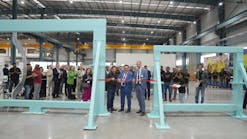Basic theory and operation
By Joe Escobar
Turbine engines power many of today's aircraft. The power that is generated by these engines relies on the expanding gas that is the result of combustion in the combustion section. In order to provide this, it requires high-pressure air to mix with the fuel for ignition. The compressor section of the engine has the important task of providing a sufficient quantity of compressed air to satisfy the requirements of combustion. It increases the pressure of the mass of air that is received at the inlet and provides it to the combustion section at the required pressure. Another purpose of the compressor section is to provide bleed air for various systems. This article, based on AC65-12A, will take a brief look at the basic construction and operation of typical turbine engine compressor sections.
Compressor types
There are two basic types of compressors - axial flow and centrifugal flow. The difference between them is the way that the air flows through the compressor.
Axial flow
In an axial flow compressor, air is compressed while continuing its original
direction of flow. From inlet to exit the air flows along an axial path and is compressed at a ratio of approximately 1.25 to 1.
An axial flow compressor has two basic elements - a rotor and a stator. The rotor has blades that are fixed on a spindle. These blades impel air rearward in the same way a propeller does. They are basically small airfoils. The rotor turns at a high speed and impels the air through a series of stages. A high velocity airflow is produced.
After the air is impelled by the rotor blades, it goes through the stator blades. The stator blades are fixed and act as diffusers at each stage. They partially convert high velocity air into high pressure. Each rotor/stator pair is a compressor stage.
Each consecutive compressor stage compresses the air even more. The number of stages is determined by the amount of air and total pressure rise required. The greater the number of stages, the higher the compression ratio.
Centrifugal-flow
In a centrifugal-flow engine, the compressor performs its job by picking up the entering air and accelerating it outwardly through centrifugal action. It basically consists of an impeller (rotor), a diffuser (stator), and a compressor manifold. The two main elements are the impeller and diffuser.
The impeller's function is to pick up and accelerate the air outwardly to the diffuser. It may be either single entry or double entry. Both are similar in construction to a piston engine supercharger impeller. The double impeller is similar to two impellers back to back. However, because of the much greater combustion air requirements in turbojet engines, the impellers are larger than supercharger impellers.
The main differences between the two types of impellers are the size and the ducting arrangement. Double-entry types have a smaller diameter, but are usually operated at a higher rotational speed to ensure sufficient airflow. The single-entry impeller permits convenient ducting directly to the impeller eye (inducer vanes) as opposed to the more complicated ducting necessary to reach the rear side of the double-entry type. Although they are slightly more efficient in receiving, single-entry impellers need to be large in diameter to deliver the same amount of air as the double-entry type. Of course, this increases the overall diameter of the engine.
A plenum chamber is included in the ducting for double-entry compressor engines. This chamber is necessary because the air must enter the engine at almost right angles to the engine axis. Therefore, in order to give a positive flow the air must surround the engine compressor at a positive pressure before entering the compressor.
Some centrifugal-flow compressor sections also include auxiliary air intake doors (blow-in doors) as part of the plenum chamber. These doors provide air to the engine compartment during ground operation when air requirements for the engine exceed the airflow through the inlet ducts. The doors are held closed by spring action when the engine is not operating. During operation, the doors open automatically whenever engine compartment pressure drops below atmospheric pressure. During takeoff and flight, ram air pressure in the engine compartment aids the springs in holding the doors closed.
The diffuser of a centrifugal-flow compressor section is an annular chamber provided with a number of vanes that form a series of divergent passages into the manifold. The diffuser vanes direct the flow of air from the impeller to the manifold at an angle designed to retain the maximum amount of energy that is provided by the impeller. They also deliver the air to the manifold at a velocity and pressure satisfactory for use in the combustion chambers.
The compressor manifold diverts the airflow from the diffuser, which is an integral part of the manifold, into the combustion chambers. The manifold has one outlet port for each chamber so that the air is evenly divided. A compressor outlet elbow is bolted to each of the outlet ports. These air outlets are constructed in the form of ducts and are known by a variety of names, such as air outlet ducts, outlet elbows, or combustion chamber inlet ducts. These ducts perform a very important part of the diffusion process - they change the radial direction of the airflow to an axial direction, where the diffusion process is completed after the turn. To help the elbows perform this function in an efficient manner, turning vanes (cascade vanes) are sometimes fitted inside the elbows. These vanes reduce air pressure losses by presenting a smooth, turning surface.
There are inherent advantages and disadvantages to each type of compressor. Knowing this, some of today's engine manufacturers utilize the advantages of each type by using a combination of both in their compressor section. Here are some of the advantages and disadvantages of each type of compressor.
Advantages/disadvantages
Centrifugal flow compressor
Advantages:
- Light weight
- High-pressure rise per stage
- Simplicity of manufacture, thus low cost
- Low weight
Disadvantages:
- Large frontal area for given airflow
- More than two stages are not practical because of losses in turns between stages
Axial flow compressor
Advantages:
- The ability to handle large volumes of airflow and a high-pressure ratio
- Small frontal area for given airflow
- Straight-through flow, allowing high ram efficiency
Disadvantages:
- More susceptible to foreign object damage
- Expensive to manufacture
- Very heavy in comparison to the centrifugal compressor with the same compression ratio
Bleed air
The compressed high temperature air that is produced by the compressor
section can be bled off and used for various functions. Bleed air can be taken from any of the various pressure stages of the compressor section. The location of the bleed air port is dependent on the pressure or temperature required for a particular job. Bleed air ports are small openings in the compressor case at the associated compressor stage. So varying degrees of pressure or temperature are achieved by tapping into the appropriate stage. Often air is bled from the final stage since this is where the pressure and temperature are at their highest.
Some applications for bleed air include:
- Cabin pressurization, heating, and cooling
- De-icing
- Pneumatic starting of engines
- Auxiliary drive units
- Control-booster servosystems
- Power for running instruments
Sometimes it is necessary to cool the bleed air coming from the engine as in the case of cabin pressurization. In these cases some type of refrigeration unit or heat exchanger is used to cool the air down.
Engine compressors have numerous uses. They are a vital part of a turbine engine, providing the high-pressure, high-temperature air for combustion as well as bleed air for system operation. What type compressor is powering your engine?





